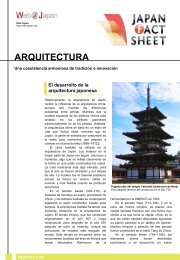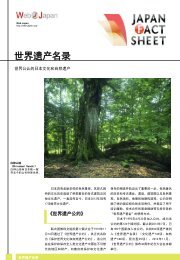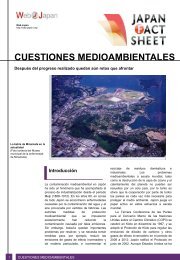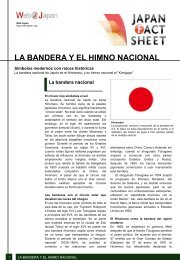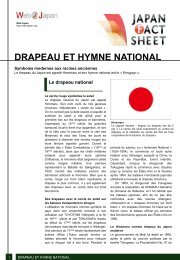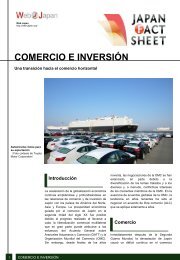Art - Web Japan
Art - Web Japan
Art - Web Japan
You also want an ePaper? Increase the reach of your titles
YUMPU automatically turns print PDFs into web optimized ePapers that Google loves.
<strong>Web</strong> <strong>Japan</strong><br />
http://web-japan.org/<br />
ART<br />
A legacy spanning two millennia<br />
Scroll painting<br />
Kasugashinkozu scroll<br />
painting. (Photo<br />
courtesy of National<br />
Archives of <strong>Japan</strong>)<br />
Diverse factors have contributed to the<br />
development of <strong>Japan</strong>ese art. Both<br />
technologically and aesthetically, it has for<br />
many centuries been influenced by Chinese<br />
styles and cultural developments, some of<br />
which came via Korea. More recently,<br />
Western techniques and artistic values have<br />
also added their impact.<br />
However, what emerged from this history<br />
of assimilated ideas and know-how from other<br />
cultures is an indigenous expression of taste<br />
that is uniquely <strong>Japan</strong>ese.<br />
Ancient Times<br />
The first settlers of <strong>Japan</strong>, the Jomon people<br />
(roughly 10,000 B.C. to 300 B.C.), crafted<br />
clay figurines called dogu, many of which<br />
represented women. Afterwards, the Yayoi<br />
people (approximately 300 B.C. to A.D. 300),<br />
whose core was a different immigrant group<br />
in the beginning of the era, manufactured<br />
copper weapons, bronze bells, and kiln-fired<br />
ceramics. Typical artifacts from the Kofun<br />
(Tumulus) period (approximately A.D. 300 to<br />
A.D. 710) that followed are bronze mirrors<br />
and clay sculptures called haniwa, which<br />
were erected outside of tombs.<br />
The simple stick figures drawn on dotaku,<br />
bells produced in the Yayoi period, as well as<br />
the murals adorning the inside walls of tombs<br />
in the Kofun period, represent the origins of<br />
<strong>Japan</strong>ese painting.<br />
1 ART
Ink painting<br />
(Photo courtesy of AFLO)<br />
The Influence of<br />
Buddhism and China<br />
Painting began to flourish in the sixth century,<br />
when the ruling class took great interest in<br />
Buddhism and Buddhist culture, which had<br />
arrived from Korea and China. Paintings<br />
preserved from the late seventh and early<br />
eighth centuries were executed in styles<br />
developed in China in the late period of the<br />
Six Dynasties (222–589). They illustrate the<br />
life of Buddha and depict other Buddhist<br />
deities. After the tenth century, painting<br />
became increasingly influenced by Jodo<br />
Shinko (Pure Land Buddhism).<br />
With impetus from the ruling class,<br />
temples and monastic compounds were<br />
constructed in various locations from the late<br />
sixth to the early seventh century. Notable<br />
examples are Asukadera, Shitennoji, and<br />
Horyuji. In the interior of these temple<br />
complexes, especially the halls and chapels,<br />
a substantial amount of Buddhist art was<br />
commissioned. The murals in Horyuji’s Kondo<br />
(Golden Hall) are some of the most important<br />
paintings of the period. We can also see<br />
sculptures representing various Buddhas,<br />
Bodhisattvas, and guardian deities in these<br />
temples. Prime among them is the Shaka<br />
Trinity, a sculpture housed at Horyuji. By the<br />
middle of the Heian period (794–1185), a<br />
clearly indigenous style, called yamato-e, had<br />
begun to replace Chinese modes of painting.<br />
Yamato-e depicts the scenery around Kyoto,<br />
and its earliest examples are seen on sliding<br />
and folding screens. Along with this new,<br />
native style came two new formats for<br />
painting: the album leaf and the illustrated<br />
handscroll, called emaki. The Tale of Genji<br />
Scrolls (ca. 1120) are the most famous emaki.<br />
In the late twelfth century, although power<br />
shifted remarkably from the nobility to the<br />
samurai class, the nobility, as well as the<br />
administrators of temples and shrines,<br />
continued to retain great wealth and remained<br />
as patrons of various genres of art. The<br />
Kamakura period (ca. 1185–1333), whose<br />
name is taken from the place where the new<br />
seat of government was established, is<br />
characterized by two major trends: realism,<br />
which aimed to satisfy the taste of the<br />
samurai class, and conservatism, which<br />
epitomized the nobility’s taste in art.<br />
Realism is most manifest in the form of<br />
sculpture. Unkei, the most noted sculptor of<br />
the Kei school (creators of a realistic<br />
sculptural style), has among his most<br />
accomplished works the two Nio guardian<br />
images at the gate of Todaiji and the wooden<br />
sculptures of two Indian sages, Muchaku and<br />
Seshin, at Kofukuji.<br />
Zen Buddhism, which spread in the<br />
thirteenth century, introduced architecture and<br />
artistic works significantly different from those<br />
of other sects. In the fourteenth century, scroll<br />
painting largely gave way to ink painting,<br />
which took root in the prominent Zen<br />
monasteries of Kamakura and Kyoto. Zen<br />
painters—and more importantly, their<br />
patrons—showed a preference for an austere<br />
monochrome style, as introduced from Sung<br />
(960–1279) and Yuan (1279–1368) China. By<br />
the end of the 1400s, Zen painters and their<br />
patrons in Kyoto had developed a preference<br />
for monochrome landscape painting, called<br />
suibokuga. Among those Zen painters was<br />
Sesshu, a priest who went to China and<br />
studied Chinese paintings.<br />
Painting in the late sixteenth century was<br />
dominated by the Kano school, which enjoyed<br />
the backing of powerful sovereigns such as<br />
Oda Nobunaga. It was a polychrome style<br />
that aimed for maximum effect in the form of<br />
screen and wall painting. The most<br />
remarkable figure of the school was Kano<br />
Eitoku.<br />
2 ART
Ukiyo-e print<br />
Utagawa Hiroshige's ukiyo-e print<br />
Tokaido gojusan tsugi: Nihonbashi<br />
(The Fifty-Three Stations of the<br />
Tokaido: Nihonbashi). (Photo<br />
courtesy of AFLO)<br />
The Edo Period<br />
(1603–1868)<br />
The Tokugawa shogunate came to power in<br />
1603 and succeeded in bringing peace and<br />
stability to <strong>Japan</strong>, both economically and<br />
politically. As the merchants in Edo (later<br />
Tokyo) and Kyoto became more and more<br />
wealthy under its regime, they began to take<br />
control of cultural activities.<br />
Paintings from the period called Kan’ei<br />
(1624–1644) depicted people from every<br />
class of society crowding the entertainment<br />
district beside Kyoto’s Kamogawa river.<br />
Similar districts existed in Osaka and Edo,<br />
where the uninhibited lifestyle of the ukiyo<br />
(floating world) transpired, that ultimately<br />
came to be glorified by the art genre known<br />
as ukiyo-e. These ukiyo-e, which often<br />
featured brothel districts and kabuki theater,<br />
gained popularity throughout the country. First<br />
produced in the form of paintings, by the early<br />
eighteenth century ukiyo-e were most<br />
commonly produced as woodblock prints.<br />
Among the first types of printed ukiyo-e<br />
were sex manuals called shunga<br />
(pornographic pictures). These books or<br />
albums showed very explicit love scenes.<br />
There were also picture books with<br />
commentary that contained portraits of the<br />
leading prostitutes of the time, typically<br />
involved in some mundane activity such as<br />
washing their hair. It is their poses or the<br />
draping of their kimono that provides the main<br />
focus of these scenes.<br />
By late in the century, the core activity of<br />
ukiyo-e had moved from the Kyoto-Osaka<br />
area to Edo, where portrayals of kabuki actors<br />
became standard subject matter. The public<br />
also showed great fondness for ukiyo-e<br />
featuring beautiful women.<br />
By the late eighteenth century, ukiyo-e<br />
had entered its golden age. Feminine beauty,<br />
and especially the tall, graceful women who<br />
appeared in the work of Torii Kiyonaga, was a<br />
dominant theme in the 1780s. After 1790<br />
came a rapid succession of new styles,<br />
introduced by artists whose names are so<br />
well known today: Kitagawa Utamaro ,<br />
Toshusai Sharaku, Katsushika Hokusai, Ando<br />
Hiroshige, and Utagawa Kuniyoshi, to single<br />
out but a few.<br />
For some Westerners, including the<br />
greatest artists in Europe in the late<br />
nineteenth century, ukiyo-e was more than<br />
merely an exotic art form. <strong>Art</strong>ists such as<br />
Edgar Degas and Vincent van Gogh<br />
borrowed its stylistic composition,<br />
perspectives, and use of color. Frequent use<br />
of themes from nature, which had been rare<br />
in Western art, widened painters’ selection of<br />
themes. Émile Gallé, a French artist and<br />
glass designer, used Hokusai’s sketches of<br />
fish in the decoration of his vases.<br />
The Kano school continued to expand its<br />
influence and managed to establish itself as<br />
the painting academy of the Tokugawa<br />
Shogunate. In contrast to the Kano school,<br />
which was patronized by the authorities of the<br />
day and passed traditions down through a<br />
system of heredity or from master to<br />
apprentice, the Rinpa school was a style of<br />
painting that developed through the<br />
inspiration and influence gained from other<br />
artists rather than the heredity system which<br />
was common at the time. The best known<br />
figure in the Rinpa school was Ogata Korin,<br />
who was active in the middle of the Edo<br />
period (1603–1868). Once apprenticed to a<br />
Kano style master painter, Korin was<br />
influenced by the works of predecessors such<br />
as Tawaraya Sotatsu, who was known for<br />
bold composition and designs. Korin went on<br />
to develop a distinctive style that reflected the<br />
new sensibilities of the age. His style, known<br />
for its decorative aesthetics and refined<br />
design, had a huge influence over the art<br />
world, not just painting but also craft designs.<br />
With the advent of the Meiji period (1868–<br />
1912) and its policy of Westernization, ukiyo-e,<br />
which had always been closely linked to the<br />
culture from which it drew its themes and<br />
vitality, began to die out quickly.<br />
Meanwhile, European painting influenced<br />
a growing number of <strong>Japan</strong>ese painters late<br />
in the Edo period. Major artists such as<br />
Maruyama Okyo, Matsumura Goshun, and Ito<br />
Jakuchu combined aspects of <strong>Japan</strong>ese,<br />
Chinese, and Western styles.<br />
3 ART
The National <strong>Art</strong> Center<br />
A transparent atrium is<br />
characteristic<br />
Culture in <strong>Japan</strong> underwent a rather dramatic<br />
transformation during the Meiji period, when<br />
Western technologies and concepts of<br />
government began to be studied and, where<br />
appropriate, adapted for the good of the<br />
nation. In the course of this program of<br />
modernization, Western-style painting<br />
received official sanction, and the government<br />
sent a number of painters overseas to study.<br />
After some decades of rivalry between<br />
traditional <strong>Japan</strong>ese-style and the new<br />
Western-style painting, the Taisho period<br />
(1912–1926) was one in which Western<br />
influence on the arts expanded greatly.<br />
Modern Times<br />
Painters such as Umehara Ryuzaburo and<br />
Yasui Sotaro studied and promoted the styles<br />
of Paul Cezanne, Pierre Auguste Renoir, and<br />
Camille Pissarro.<br />
In the pre-World War II years, however,<br />
Yasui and Umehara cast off the mostly<br />
derivative character of Western-style painting<br />
in <strong>Japan</strong>. Umehara stands out for having<br />
brought to his work elements of <strong>Japan</strong>ese<br />
style, an innovation reversal that encouraged<br />
other Western-style painters in <strong>Japan</strong> to<br />
become more interpretative.<br />
The modernizing of <strong>Japan</strong>ese painting<br />
continued under the guidance of Yasuda<br />
Yukihiko and Kobayashi Kokei. Other painters<br />
tried to spread interest in <strong>Japan</strong>ese-style<br />
painting by adopting popular themes and<br />
giving exhibitions more frequently.<br />
It was early in the twentieth century that<br />
authentic interest in Western-style sculptures<br />
gained momentum, when artists returned to<br />
<strong>Japan</strong> from study abroad. Representative of<br />
those sculptors was Ogiwara Morie, who<br />
introduced the style of Auguste Rodin and<br />
became the pioneer in the modernization of<br />
<strong>Japan</strong>ese sculpture. Another influential<br />
sculptor was Takamura Kotaro who, as an<br />
outstanding poet as well, translated Rodin’s<br />
views on art.<br />
Following the unproductive years of World<br />
War II, art in <strong>Japan</strong> rapidly regained its<br />
originality. Western artistic trends, after the<br />
war, found a quick reception in <strong>Japan</strong>,<br />
including such developments as pop and op<br />
art, primary structure, minimal art, kinetic art,<br />
and assemblage.<br />
Having traditionally taken their lead from<br />
the art of other cultures, <strong>Japan</strong>ese artists are<br />
now finding their own expression as original<br />
creators and contributors to the world art<br />
community. To mention a couple: Okamoto<br />
Taro, who published his works at the 1953<br />
São Paulo Biennale and 1954 Venice<br />
Biennale, and designed the symbol of the<br />
international exposition held in Osaka in 1970,<br />
Taiyo no To (Sun Tower); and Ikeda Masuo,<br />
who published many printed works full of<br />
eroticism and irony, which established his<br />
fame worldwide. Ikeda also won the Grand<br />
Prix for printmaking at the 1966 Venice<br />
Biennale. Additionally, Hirayama Ikuo is<br />
highly respected for his pictures depicting Silk<br />
Road landscapes filled with fantasy. Iwasaki<br />
Chihiro, who painted pictures for children, is<br />
widely acclaimed for her portraits of them.<br />
Most of her pictures were painted for picture<br />
books, and these books are published in<br />
more than 10 countries. The artist Kusama<br />
Yayoi, who began by trying to capture the<br />
hallucinations which she suffered from as a<br />
child, creates paintings and other works with<br />
a repetitive motif of dots and net patterns and<br />
has exhibited in galleries and exhibitions all<br />
over the world. <strong>Art</strong>ists such as Nara<br />
Yoshitomo, whose pictures of little girls with<br />
glowering eyes depict a world which is both<br />
cute and eerie, and Murakami Takashi, who<br />
draws on the typically <strong>Japan</strong>ese culture of<br />
manga and anime for his life-sized figures of<br />
young women, etc., are very popular,<br />
especially among young people.<br />
4 ART



